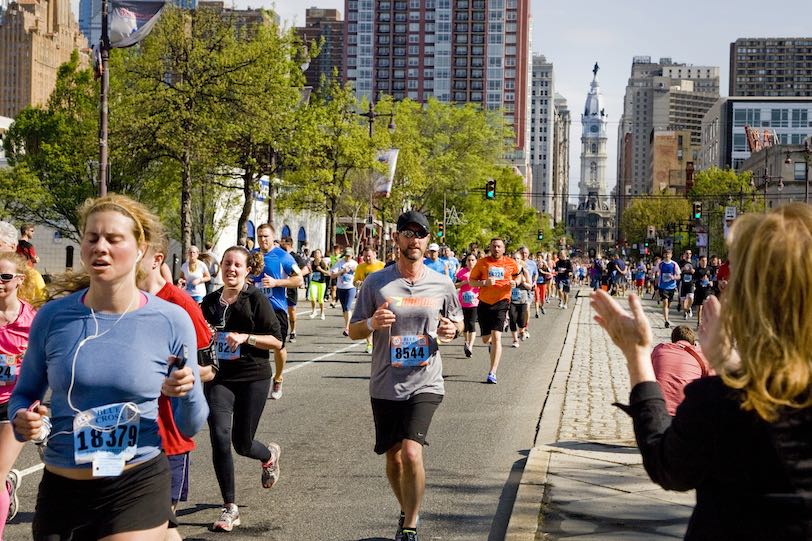The Procrastinator’s Guide to Training for the Broad Street Run in Under a Month
Oops, just realized that the Broad Street Run is right around the corner? Here's how to get ready to race.

Photo by M. Edlow for VISIT PHILADELPHIA™
If you’re reading, I’m going to assume you’ve found yourself with less than a month until the Broad Street Run on May 6 — and way behind in your training. It’s okay — life gets busy sometimes, and long runs that you kept meaning to reschedule never found a home on your calendar. It happens.
Related: Mental Strategies to Power Through the Broad Street Run
It’s not a complete lost cause to start your training now — though I do suggest adjusting your expectations to “I just want to finish the ten-mile run.” If you’re cool with that, here’s a few tips that’ll help you cross the finish line.
Evaluate Your Current Fitness Level
The first step to getting started is to evaluate where your fitness level is today. You’ll need to honestly answer questions such as: How many miles can you comfortably, without strain, run today? How much exercise have you done over the past month or more? How susceptible to injury are you?
Plan for Rest Days
Now with those questions in mind, you can start to lay out a plan to get you closer to being prepared for race day. One of the first rules I suggest you follow is to never to run two days in a row. Always allow at least one rest day between each running day. Since most runs will be challenging, you’ll want to allow for proper recovery.
Ignore Your Pace
Next, though it’s hard, go ahead and forget about pace. Don’t try and hammer out each run. Run by effort, keeping the effort below a four or five out of ten. You want to keep the accumulated fatigue of running multiple days fairly mild. The priority needs to be increasing distance, not pace. Your focus should be on preparing for running ten miles — not ten miles as fast as you can. Save that for race day.
Find Your Base Distance
Now that we know the plan is to run every other day (or less) — and not to worry about pace — we can start planning out each run. Your first run should be at your current comfortable distance, whatever that may be. It’s ok to run/walk this if needed. The purpose of this run is to find what I call your “base distance.”
Make Your Runs Longer — Not Faster
For each subsequent run after, you’ll want to add time to your base distance. Listen to your body on how much. We want to stress your limit just a tad beyond comfortable. The key here is to keep the pace super easy — remember we’re not trying for pace. The goal is only extending distance or time. There is an opposite relationship between pace and time. A faster pace will negatively affect duration, whereas a slower pace will have a positive effect on duration of your run.
Push Yourself, But Not Too Much
Each run, increase the time spent running by five or ten minutes. Plan for one long run on the weekends that’s maybe ten to 30 minutes longer, but listen your body and stop shortly after it gets too hard. The key is being able to come back and run one or two days later. I always tell my clients to look forward: Don’t let today’s run affect the next run and cause you to take an extra day to recover.
Don’t Worry About Running Ten Miles Before Race Day
Lastly, don’t fret about running ten miles before Broad Street. The body is capable of handling much more then you think. Training plans for a marathon or longer rarely include a training run of the race distance. While it’s not an ideal situation, follow these rules and you’ll be in better shape than you are today.
Forget About a Taper
There’s no time.
Cory Smith is a Philadelphia based running coach; founder of Run Your Personal Best, an online running-coaching business and former head cross country coach at Penn State Brandywine. He is a USA Track and Field-certified Endurance Level 2 coach and a 4:03 miler. As a student athlete at Villanova, Cory was a multiple-time NCAA Division One Regional qualifier and two-time National Championship qualifier. Contact Cory at cory@runyourpersonalbest.com. Read all of Cory’s posts for Be Well Philly here.
Like what you’re reading? Stay in touch with Be Well Philly—here’s how:
- Like Be Well Philly on Facebook
- Follow Be Well Philly on Instagram
- Get the Be Well Philly Newsletter
- Follow Be Well Philly on Twitter


